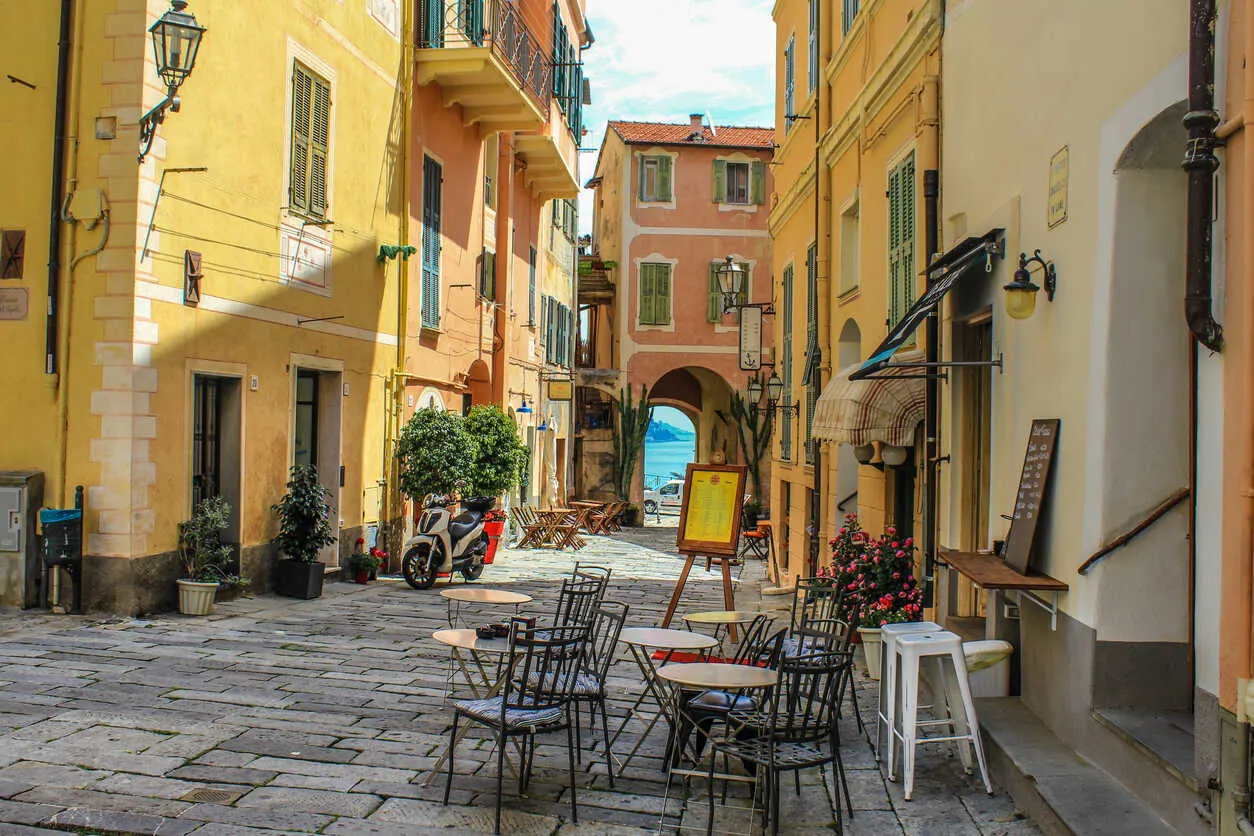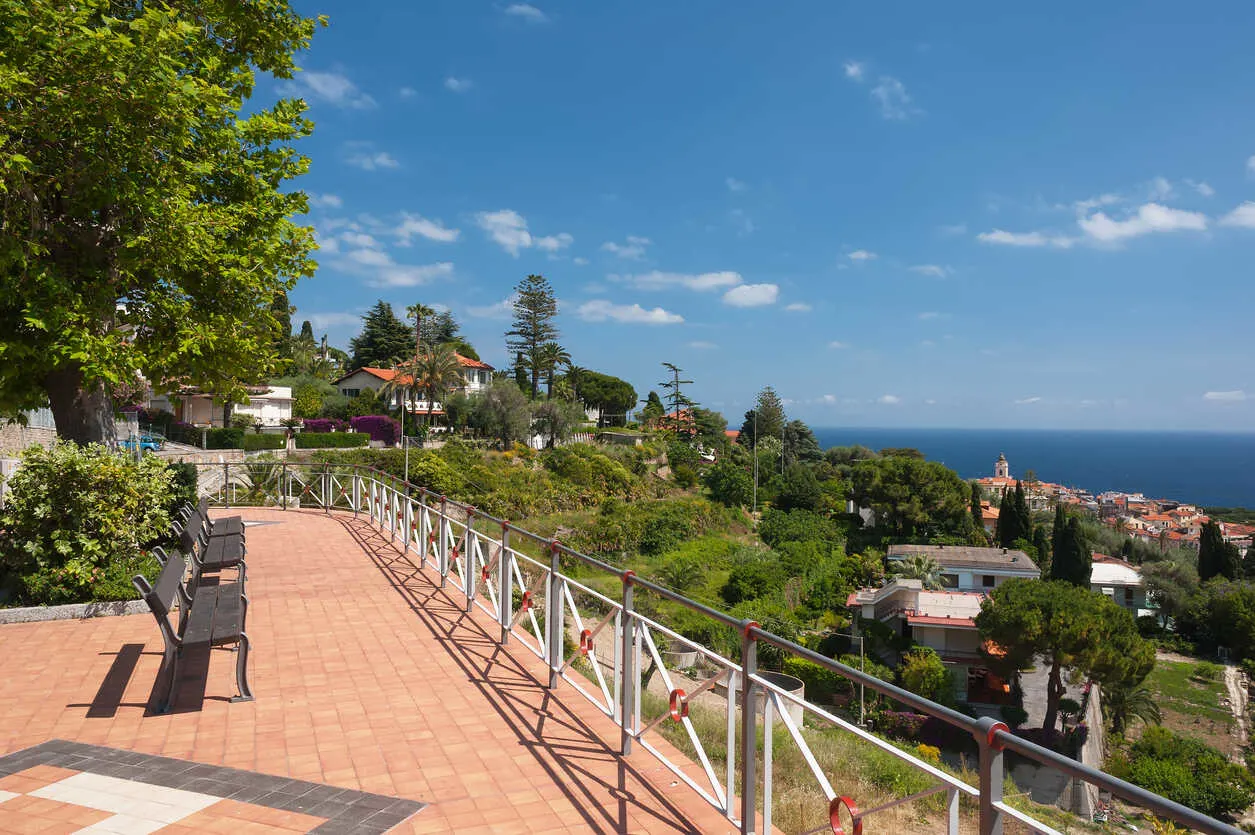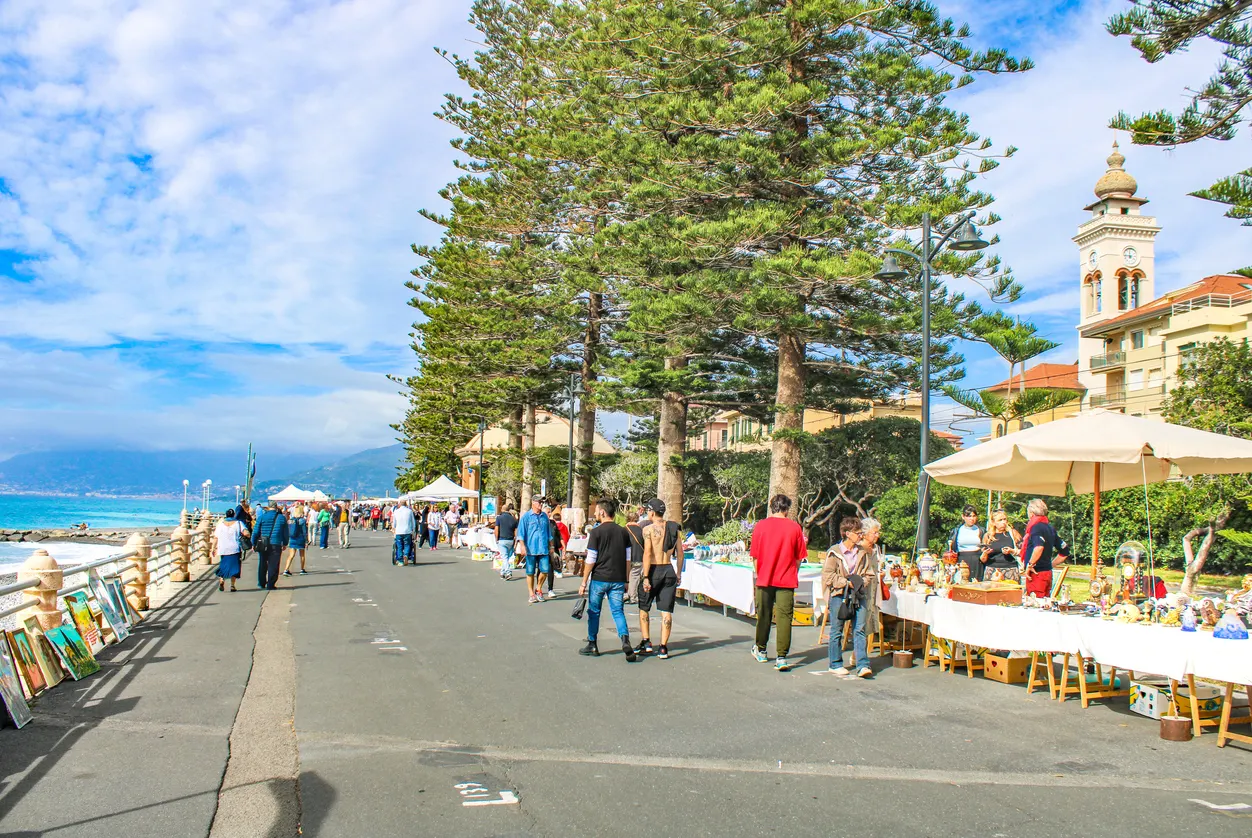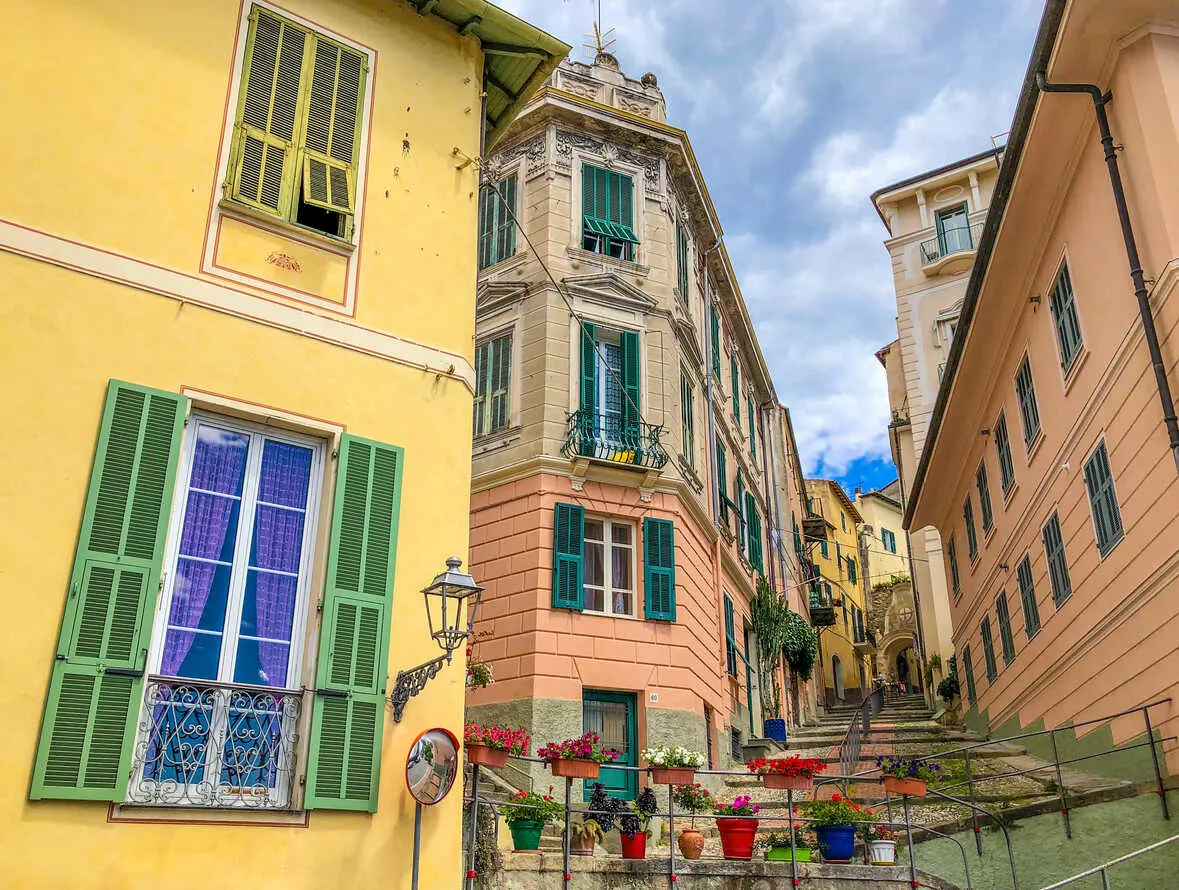We didn’t mean to fall in love. Indeed, Bordighera was meant to be no more than a brief fling. It was simply necessary for us to take a break from our travels through southern France. Teresa (my beloved spouse) is a joint US-EU citizen, so she and her oh-so-lucky husband can flâner around the continent as long as we want, provided we don’t stay more than three months at a time in any one nation.
The clock was running out in France, so we had to hop over a border somewhere…
Si va in Italia, bello!
We chose Bordighera because Acqua di Mare, the beachview B&B Teresa found for us, was half the price of similar places along the French coast (€382 euros for three nights). We would save a little money, comply with EU regulations, and then return to our regular French travel program.
We did not anticipate that we would be so utterly beguiled by Bordighera.
Get Your Free Italy Report Today!
Get Your Free Italy Report Today!
Learn more about Italy and other countries in our daily postcard e-letter. Simply enter your email address below and we’ll send you a FREE report – Italy: Europe’s Most Seductive Country.

By submitting your email address, you will receive a free subscription to IL Postcards, Overseas Dream Home, The Untourist Daily and special offers from International Living and our affiliates. You can unsubscribe at any time, and we encourage you to read more about our Privacy Policy.
A Disastrous Trip Leads to… a New Favorite Destination?

In truth, however, getting there was somewhat frightening. We took the Corniche Expressway, which is constructed in the high hills above the coast. This literal highway consists of a series of tunnels through the mountains and elevated bridges over the gorges. In some stretches, we flashed back and forth between darkness and dizzying heights.
While views of the town and beaches on the Riviera far below were spectacular, I didn’t dare take my eyes from the road for more than a second. Massive transport trucks filled the "slow" right lane, requiring me to pass them. Meanwhile, in the left lane Porsches and BMWs zoomed along as if practicing for Monaco’s Formula One trials.
Teresa, sitting next to me, was having no fun either. She squeaked out every now and then, "This bridge is just too high!"
So, we heaved a mutual sigh of relief when we finally found the exit ramp for Bordighera.
The road slithered down from the Corniche, passing pastel-colored villas precariously perched on the slopes. As we descended, the town came into view, stretched out as if squeezed between the steep hills and the waterfront. As we drove into town, we passed through a large urban park, completely shaded by great evergreen trees.
We found our little B&B just below the old town right on the shore. It had a waterfront terrace, which was the main reason Teresa booked it for us. She’d also read reviews that said passing trains kept some guests awake at night. Well, how bad could it be?
It turned out the tracks ran right past our terrace, so close that with a running start we might’ve been able to catch hold of a passing train.
But this was not the clackity-clackity-clack of an American train. This was the swoosh of the high-speed TGV between Paris and Genova. These trains were ghostly fast and mostly silent (even the more local ones). After the first night, to our amazement, we barely noticed them pass.
The High Town Requires a Second Look

We discovered that there are really three towns in Bordighera: the ancient "high town," the downtown beach promenade, and the old English "colony" filled with fancy old villas, hotels, and gardens.
The high town is the ancient citadel: a cluster of tightly packed, ancient stone homes upon a hill not far from our B&B.
We walked up that hill our first evening to explore. The high town is filled with narrow streets and three-story row houses that let in just a sliver of sunlight.
Most of these streets are pedestrian-only, simply because they’re too narrow for cars; the whole area was built long before anyone dreamed of an engine that could internally combust.
It’s not a pretty place—at first glance. Parts look run down and a bit shabby. Obviously, this is not where tourists live.
But I liked the creative flourishes that filled these old streets. On one wall hung several flower pots, backed by a frame, as if a "still life" had sprung to life.
We found old bicycles parked here and there on the streets, repurposed as flower baskets. They were decorated—spokes to handlebars—and transformed into whimsical works of art.
And wherever there was a terrace, we found a café or restaurant—with each of the menus in four languages. At the local gelaterias, I found a brand-new flavor to savor: violet! The delicate mauve treat tasted floral, but creamy and sweet.
The Longest Waterfront Promenade on the Riviera

Our first morning we walked into town along the waterfront.
At first, the way was just a rough trail running next to the train tracks. We passed a marina and then a little waterfront chapel before coming to the proper promenade. It’s as wide as a two-lane street, and runs along the shore for 1.5 miles. Apparently, it’s the longest promenade on the Riviera.
The promenade is accessible only by bridges underneath the rail line, effectively separating the beach from the workaday business section of town. This gives the promenade its own distinct identity.
We found it delightfully quiet as we strolled along—no traffic jams by the seashore, as in Nice or Cannes, just the occasional express train to intrude upon the crashing of the waves.
There were surprisingly few restaurants and cafés, and no shops at all. Only a handful of walkers sauntered along that morning, and we revelled in the peaceful energy.
The beach itself alternated between small gray stones and gray sand; certainly not the best on the Riviera, but we hadn’t come to swim.
Neither had the British in the 1800s. They were here for the sun and fresh breezes—a cup of tea on the terrace, and a promenade in the afternoon, like we were enjoying.
Get Your Free Italy Report Today!
Get Your Free Italy Report Today!
Learn more about Italy and other countries in our daily postcard e-letter. Simply enter your email address below and we’ll send you a FREE report – Italy: Europe’s Most Seductive Country.

By submitting your email address, you will receive a free subscription to IL Postcards, Overseas Dream Home, The Untourist Daily and special offers from International Living and our affiliates. You can unsubscribe at any time, and we encourage you to read more about our Privacy Policy.
A Trip to The Riviera For The Budget-Savvy
Visit Bordighera, and you’ll find that its costs—and those of surrounding Riviera towns—is 30%-50% less for food and lodging than on the French side of the Riviera border.
Sure, we could tell we were in Italy: The roads were a bit more run down, the streets a bit dirtier than in France. But the food and wine? Cheap and delicious, especially in the high town.
Relaxed Elegance in the "English Colony"

Just inland from the promenade is where fancy villas and stately hotels spread out: a luxurious area of verdant parks and gardens filled with palms, flowering trees, and rose bushes everywhere. There’s even a "lawn tennis" club.
This is where you really experience Bordighera. It turns out this little strip of the Ligurian coast, where the alps end and the sea begins, has a microclimate. It has some 330 sunny days per year, and it was the first place date palms were cultivated in all of Europe. In fact, one of the town’s claims to fame is that it provides palm fronds to the Vatican each spring for the Pope’s celebration of Palm Sunday.
We could easily see why the British loved it here. Imagine coming from a sooty London winter to this paradisiacal place.
Many of the hotels and private apartment buildings had beautiful Art Nouveau and Art Deco flourishes that have been lovingly maintained or restored. There’s a general creaminess about them all—as if they’re giant layer cakes, not solid stone.
The architecture gives the whole district an aura of relaxed elegance. No surprise, then, that Bordighera drew famous architects including Charles Garnier, who designed the famous Paris opera house that bears his name. Riccardo, the owner of our B&B, told us that Garnier designed the most beautiful villa in Bordighera.
It was just five minutes up the road from us.
Its gleaming, white tower rose up like a castle turret, easily visible from the train tracks. Elegant, moorish arches added an exotic flavor to the villa, and it became our landmark for finding our way home. Riccardo told us a priest lives there now, and that he operates it as a Catholic retreat center— a B&P (bed and prayer).
The Impressionist master Claude Monet also came to Bordighera in 1884 to paint. One of his masterpieces, "Les Villas à Bordighera," hangs in the Beaux Arts Museum in Nice where I stumbled upon it by chance.
Next to the painting is a quotation from one of Monet’s letters about this and his other paintings of this pretty little place: "This will perhaps make the enemies of blue and pink cry out a little, for it is precisely this brilliance, this fairylike light that I am striving to render, and those who have not seen this county… will cry out that it is plausible, even through I have fallen short of the mark."
We were sad when it was time for us to drive back to France. We were impressed how the town managed to keep its character intact, even as it had welcomed tourists for so long. It built a whole district for them—but did so with class and elegance that we have seldom seen in Riviera beach towns.
We promised ourselves we would come back to beguiling Bordighera again. Next time, though, we’ll skip the Corniche and take the train.
A Retreat For The Ages
The British upper classes were captivated by little Bordighera.
It all started with a novel, Doctor Antonio, written by the Italian revolutionary Giovanni Ruffini, but first published 1855 in Edinburgh.
The eponymous fictional doctor was from Bordighera, and he fell in love with the daughter of a British aristocrat. But then, he was compelled to return home to fight for the unification of Italy — a cause for which he tragically dies at the end of the novel.
The author’s purpose in writing was to win the English to that noble cause, and also to inspire them to visit his native coast and create a tourist boom.
It was not unrealistic. Cannes, Nice, and Menton were already drawing so many pallid northerners to the Riviera that the French side had become crowded and expensive.
Ruffini succeeded, dramatically (and the book was remade in several movie versions, an opera, and it became the first Italian TV series).
Bordighera’s first hotel opened in 1865. It was named Hotel d’Angleterre (England Hotel). As villas and hotels began to proliferate to accommodate the annual inglese invasion, the little town became more and more popular, drawing writers for the serenity, artists for the beauty, and botanists for the biological diversity.
Get Your Free Italy Report Today!
Get Your Free Italy Report Today!
Learn more about Italy and other countries in our daily postcard e-letter. Simply enter your email address below and we’ll send you a FREE report – Italy: Europe’s Most Seductive Country.

By submitting your email address, you will receive a free subscription to IL Postcards, Overseas Dream Home, The Untourist Daily and special offers from International Living and our affiliates. You can unsubscribe at any time, and we encourage you to read more about our Privacy Policy.
